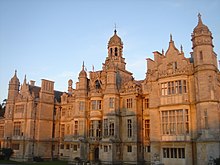This article has an unclear citation style. The reason given is: Citations are vague and missing details such as publishers. (October 2022) |
This article lacks ISBNs for the books listed. (October 2022) |
 The Jacobethan style Kingswood House, part of Kingswood Estate | |
| Years active | 1820s–1920s |
|---|---|
| Location | England |
| Influences | |
| Influenced | Tudorbethan |

The Jacobethan (/ˌdʒækəˈbiːθən/ jak-ə-BEE-thən) architectural style, also known as Jacobean Revival, is the mixed national Renaissance revival style that was made popular in England from the late 1820s,[1] which derived most of its inspiration and its repertory from the English Renaissance (1550–1625), with elements of Elizabethan and Jacobean.

John Betjeman coined the term "Jacobethan" in 1933,[2] and described it as follows:
The style in which the Gothic predominates may be called, inaccurately enough, Elizabethan, and the style in which the classical predominates over the Gothic, equally inaccurately, may be called Jacobean. To save the time of those who do not wish to distinguish between these periods of architectural uncertainty, I will henceforward use the term "Jacobethan".[3]
The term caught on with art historians. Timothy Mowl asserts in The Elizabethan and Jacobean Style (2001) that the Jacobethan style represents the last outpouring of an authentically native genius that was stifled by slavish adherence to European baroque taste.
